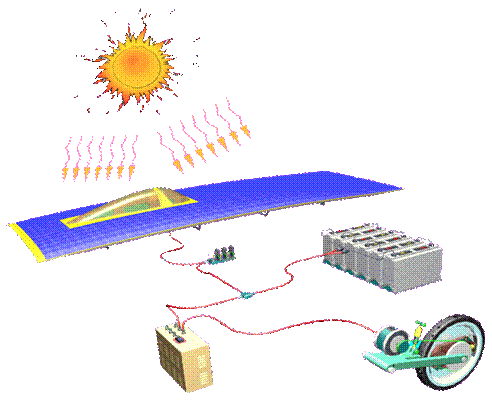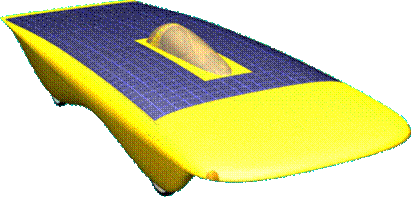





Published on Feb 14, 2025
The first solar car invented was a tiny 15-inch vehicle created by William G. Cobb of General Motors. Called the Sun mobile, Cobb showcased the first solar car at the Chicago Powerama convention on August 31, 1955. The solar car was made up 12 selenium photovoltaic cells and a small Pooley electric motor turning a pulley which in turn rotated the rear wheel shaft.
The first solar car in history was obviously too small to drive . Now let's jump to 1962 when the first solar car that a person could drive was demonstrated to the public. The International Rectifier Company converted a vintage model 1912 Baker electric car (pictured above) to run on photovoltaic energy in 1958, but they didn't show it until 4 years later. Around 10,640 individual solar cells were mounted to the rooftop of the Baker to help propel it.
In 1977, Alabama University professor Ed Passereni built the Bluebird solar car, which was a prototype full scale vehicle. The Bluebird was supposed to move from power created by the photovoltaic cells only without the use of a battery. The Bluebird was exhibited in the Knoxville, TN 1982 World's Fair.Between 1977 and 1980 (the exact dates are not known for sure), at Tokyo Denki University, professor Masaharu Fujita first created a solar bicycle, then a 4-wheel solar car. The car was actually two solar bicycles put together. In 1979 Englishman Alain Freeman invented a solar car (pictured right). He road registered the same vehicle in 1980. The Freeman solar car was a 3-wheeler with a solar panel on the roof.

The energy from the sun strikes the earth throughout the entire day . However, the amount of energy changes due to the time of day, weather conditions, and geographic location. The amount of available solar energy is known as the solar isolation and is most commonly measured in watts per meter squared or W / m 2. In India on a bright sunny day in the early afternoon the solar isolation will be roughly around 1000 W / m 2, but in the mornings, evenings, or when the skies are overcast, the solar isolation will fall towards 0 W / m 2. It must understand how the available isolation changes in order to capture as much of the available energy as possible.
The sunlight hits the cells of the solar array, which produces an electrical current. The energy (current) can travel to the batteries for storage; go directly to the motor controller, or a combination of both. The energy sent to the controller is used to power the motor that turns the wheel and makes the car moves.
Generally if the car is in motion, the converted sun light is delivered directly to the motor controller, but there are times when there is more energy coming from the may than the motor controller needs. When this happens, the extra energy gets stored in the batteries for later use.

When the solar may can't produce enough energy to drive the motor at the desired speed, the array's energy is supplemented with stored energy from the batteries.
Of course, when the car is not in motion, all the energy from the solar may is stored in the batteries. There is also a way to get back some of the energy used to propel the car. When the car is being slowed down, instead of using the normal mechanical brakes, the motor is turned into a generator and energy flows backwards through the motor controller and into the batteries for storage. This is known as regenerative braking. The amount of energy returned to the batteries is small, but every bit helps.
• This concept can be utilized to build a single sitter four wheel vehicles in practice.
• It can be extended to more commercial form of four wheeler vehicle.
• In industry where small vehicles are used to perform light weight conveys work from one place to other place.
It can be used places where, fuel based vehicles are banned due to production of pollution and noise
Solar cells or photovoltaics collect the energy from the sun and converts it into usable electrical energy. They are made from silicon by joining an n-type and a p-type silicon semiconductor, creating an electron rich and an electron poor layer. When sunlight strikes the cell, photons cause atoms of the semiconductor to free electrons, leaving behind positive charges. The flow of electrons thus created constitutes an electromotive force that drives the current to charge a battery or power a motor.
The cell's positive contact is on the bottom while the negative contact, or bus bar, is located on the top of the cell. Each cell produces approximately .5 volts and 3 amps of current. Connecting the cells in series, i.e., positive to negative, increases voltage. Parallel connections, i.e., negative to negative and positive to positive, increase current. Therefore, connecting the cells in various series and parallel configurations produces modules of different voltages and currents.
To put the limitations of a solar car in perspective, a simple calculation will suffice. Only 1000 W/m2 of energy reaches the earth’s surface in an hour of “peak sun”. This term can be thought of as the amount of sunlight that reaches a sunny area on cloudless, summer day around noon. An average solar array configuration span 8m, meaning the total amount of energy hitting the solar car during peak sun is 8KWh/m2. Of this energy, average solar cells are only able to convert 12.5% to electricity. As a result, the total amount of converted energy available to a car consists of 1 KW/h, approximately the same amount of energy used to run a hairdryer.
With cars running on 700-1500 Watts, efficiency is hypercritical. Therefore, advances in all aspects of engineering, from mechanical to electrical to materials and computer science are the key. The three primary areas of energy loss consist of aerodynamic drag, braking, and rolling resistance. To minimize aerodynamic drag, engineers make solar cells as sleek as possible. Rolling resistance is proportional to weight. Hence solar cars should be engineered to be very light.
| Are you interested in this topic.Then mail to us immediately to get the full report.
email :- contactv2@gmail.com |